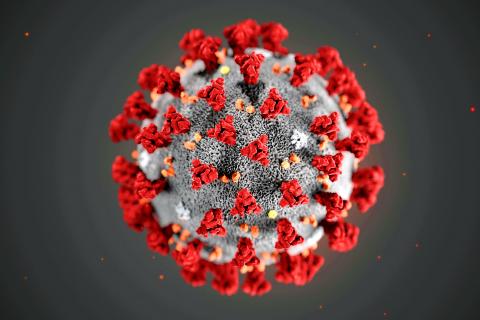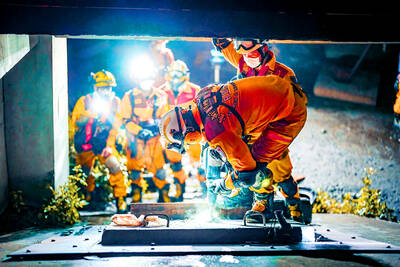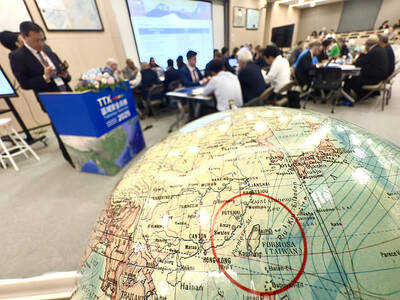Humans likely synthesized COVID-19, although more studies are needed to be certain, National Taiwan University (NTU) public health researcher Fang Chi-tai (方啟泰) said yesterday as he cited the opinions of other researchers.
During his presentation at a disease-prevention education seminar held at NTU by the Taiwan Public Health Association — which invited several public health study professors and researchers to give presentations that were also broadcast live via Facebook — Fang addressed numerous hypotheses that have been raised by foreign researchers, including the possibility that the virus was leaked from the Wuhan Institute of Virology.
He has heard of many US and Europe-based researchers who are asserting that the virus was inextricably linked to the institute, Fang said, adding this assertion was highly possible as the facility’s biosafety level 4 laboratory houses samples of SARS, Ebola and other deadly viruses.

Photo: Alissa Eckert, MS; Dan Higgins, MAM/CDC/Handout via Reuters
Given China’s poor track record with lab safety management and overall lab culture, it is highly likely that a virus escaped from the facility, he cited the opinions of other researchers as saying.
Analyses of COVID-19 have shown that is has a 96 percent genetic similarity with an RaTG13 bat virus at the institute, he said.
While viruses need to be at least 99 percent similar to call them “the same,” it is the differences in particular that have led researchers to speculate that COVID-19 was manufactured by modifying RaTG13, he said.
A French research team that examined the gene sequence of COVID-19 has discovered that it has four more amino acids than other coronaviruses, he said, adding that this makes its transmission easier.
The findings have led some in the research community to speculate about whether China’s scientists intended to develop a virus more difficult to contain than SARS, he said.
If that was their intent, they appeared to have succeeded, Fang added.
Mutations of viruses that occur naturally only result in small, singular changes, he said, adding that one would not normally see a naturally mutated virus suddenly take on four amino acids.
While such a large mutation is not impossible, it is highly unlikely, he said.
However, only an internal administrative review at the institute could rule out whether the virus was manufactured there, he said.
Such an investigation would require access to lab records, which is unlikely to happen in the short term, he added.
Determining the source of the coronavirus has important implications for epidemiology, Fang said, adding that if the virus does not occur in nature, then it is likely to be entirely stamped out.
This is quite different from forms of influenza, which cannot be easily eradicated, because they are part of the ecosystem, Fang added.

A Taiwanese software developer has created a generative artificial intelligence (AI) model to help people use AI without exposing sensitive data, project head Huang Chung-hsiao (黃崇校) said yesterday. Huang, a 55-year-old coder leading a US-based team, said that concerns over data privacy and security in popular generative AIs such as ChatGPT and DeepSeek motivated him to develop a personal AI assistant named “Mei.” One of the biggest security flaws with cloud-based algorithms is that users are required to hand over personal information to access the service, giving developers the opportunity to mine user data, he said. For this reason, many government agencies and

The National Fire Agency on Thursday said a series of drills simulating a magnitude 8.5 earthquake would be held in September to enhance the government’s emergency response capabilities. Since earthquakes cannot be predicted, only by continuously promoting disaster prevention measures could Taiwan enhance its resilience to earthquakes, agency Director-General Hsiao Huan-chang (蕭煥章) said in a news release. The exercises would be held to mark annual National Disaster Prevention Day on Sept. 21, the aim of which is to test Taiwan’s preparedness and improve its earthquake resilience in case of a major temblor, Hsiao said. As part of those drills, an earthquake alert would

DEFENSE: The National Security Bureau promised to expand communication and intelligence cooperation with global partners and enhance its strategic analytical skills China has not only increased military exercises and “gray zone” tactics against Taiwan this year, but also continues to recruit military personnel for espionage, the National Security Bureau (NSB) said yesterday in a report to the Legislative Yuan. The bureau submitted the report ahead of NSB Director-General Tsai Ming-yen’s (蔡明彥) appearance before the Foreign and National Defense Committee today. Last year, the Chinese People’s Liberation Army (PLA) conducted “Joint Sword-2024A and B” military exercises targeting Taiwan and carried out 40 combat readiness patrols, the bureau said. In addition, Chinese military aircraft entered Taiwan’s airspace 3,070 times last year, up about

STRICTER ENFORCEMENT: Taipei authorities warned against drunk cycling after a sharp rise in riding under the influence, urging greater public awareness of its illegality Taipei authorities have issued a public warning urging people not to ride bicycles after consuming alcohol, following a sharp rise in riding under the influence (DUI) cases involving bicycles. Five hundred and seven people were charged with DUI last year while riding YouBikes, personal bicycles, or other self-propelled two-wheelers — a fourfold increase from the previous year, data released by the Taipei Police Department’s Traffic Division showed. Of these, 33 cases were considered severe enough to be prosecuted under “offenses against public safety,” the data showed. Under the Road Traffic Management and Penalty Act (道路交通管理處罰條例), bicycles — including YouBikes and other